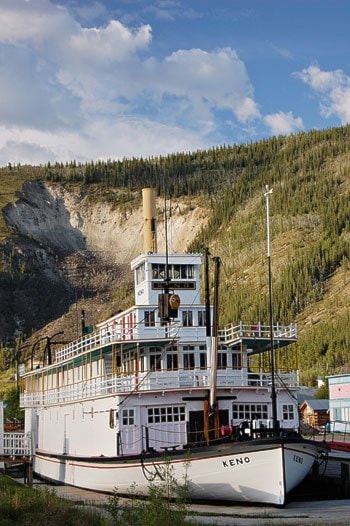David Neufeld is the Yukon and Western Arctic Historian for Parks Canada, located here in Whitehorse. Among his many responsibilities is providing interesting and thoughtful information about topics of national historic significance.
The Historic Sites and Monuments Board of Canada (HSMBC) will occasionally bestow a person, place or event in the Yukon with national historic significance.
Take the SS Klondike. It is recognized as historically important to the nation because it commemorates inland water transportation Both it and the SS Keno in Dawson City, which is also designated by HSMBC, are representative of the craft that plied Yukon waters in the first half of the 20th century. A tour of the vessel may focus visitors’ attention on the structures themselves and upon the historic furnishings. But there was more to the story than that.
I sat down with Neufeld to talk about this recently. He has been undertaking research that would help to describe the hydrological regime of the Upper Yukon River basin. This includes the ups and downs of water levels, as well as freezeup and breakup. He chose to focus on the year 1938, which falls within the period to which the Klondike has been restored and refurnished.
With help from Casey McLaughlin and Janna Swales of the Yukon Transportation Museum, he has been poring over old documents and the newspapers of the era. Among the interesting documents he had at his disposal were the log books of the Klondike and the Nasutlin. The log books were recently returned to Parks Canada by American visitors, who, as young men back in the 1960s, lifted them from the Klondike and Nasutlin, which then sat abandoned on the Whitehorse waterfront.
These books contain vital information about the operation of the steamers on the Yukon, including speed of the current (and the ship), water levels, stopping points and maximum displacement.
Yukon life in the first half of the 20th century was dependent upon water transportation, by which means, most essential goods were delivered from the Outside. People were profoundly influenced by the ebb and flow of the Yukon River. River transportation began in the spring with the break up of the ice, and continued into the fall when freezeup put an end to it for half the year.
With freezeup, almost all flow of goods to and from Dawson City came to an end. I have talked to old-timers from Dawson who recount placing their winter orders, including Christmas gifts, months in advance, to ensure they reached Dawson before river travel ended for the season.
Those who didn’t make it out on the last steamer of the season were locked inside for the winter, or faced a long, slow trip over the winter tail on an open carriage drawn by horses, and later, tractors, to reach Whitehorse. Even this travel was curtailed during the freezeup period in the fall, and just prior to breakup in the spring. It gave real meaning to the term “Outside.”
The steamers consumed thousands of cords of wood each summer, so woodlots operated all along the Yukon River to supply demand. This meant jobs for local residents, and helped maintain the population along the river. Most of these settlements and stopping points - Neufeld’s findings indicate that there were there were 45 between Whitehorse and Dawson - were abandoned when the river trade ceased.
The break up of ice on Lake Laberge controlled the beginning of transportation to Dawson. The speed of the current and levels of the river dictated how the waters were navigated, and where the riverboats could come ashore. Water levels also limited the amount of freight the ships could carry. Loads were smaller during the lower water levels of spring and fall, larger during the higher waters of mid-summer.
While the environment and fluctuations of the seasons had a profound effect upon the people who lived along the shores of the Yukon, they in turn, tried to control the environment. The British Yukon Navigation Company built a dam at the lower end of Marsh Lake to store water over the winter. When released in the spring, the surge of water facilitated the break up of the ice on Laberge. This was speeded along up by the laying of lampblack on the ice, which absorbed solar heat that helped to open a channel across the lake.
Weirs were built at Upper Laberge to maintain an open channel at the entrance to the lake. Stony obstacles lying dangerously beneath the water were blown up, and large expanses of land were cleared by the cutting of firewood along the river.
Prior to 1938, Whitehorse was merely a stopping and transfer point along the route to Dawson City, and was very much dependent upon the river commerce for its survival. The daily cycle of the town of a few hundred was marked out by the whistles that blew at the White Pass shop down on the waterfront.
Whitehorse expanded in the spring with the influx of workers in anticipation of the opening of transportation, and contracted just as quickly when the steamers stopped running in the fall. Unlike Dawson, residents here could leave the territory by train to the coast throughout the winter.
By 1938, however, changes were occurring that would alter the annual rhythm. Airplanes were providing a faster alternative to traditional means of travel. Local residents were no longer trapped in the North during the winter. The riverboats relied increasingly upon tourists to fill their cabins.
The advent of the Alaska Highway shifted the population centre from Dawson City to Whitehorse, and opened up travel to the automobile. Roads to Dawson City and Mayo/Keno meant truck hauling of goods and ore. Within a decade, the riverboats became dinosaurs.
Michael Gates is a Yukon historian and sometimes adventurer based in Whitehorse. His new book, Dalton’s Gold Rush Trail, will be available in May. You can contact him at msgates@northwestel.net
